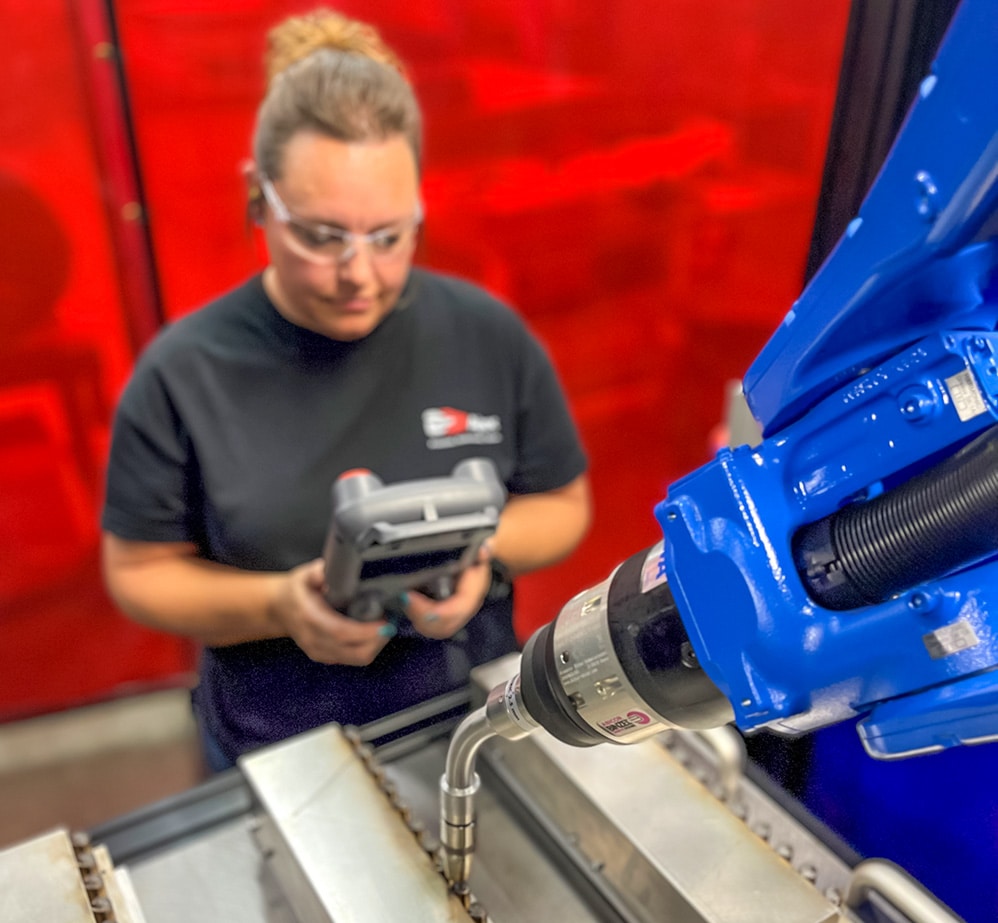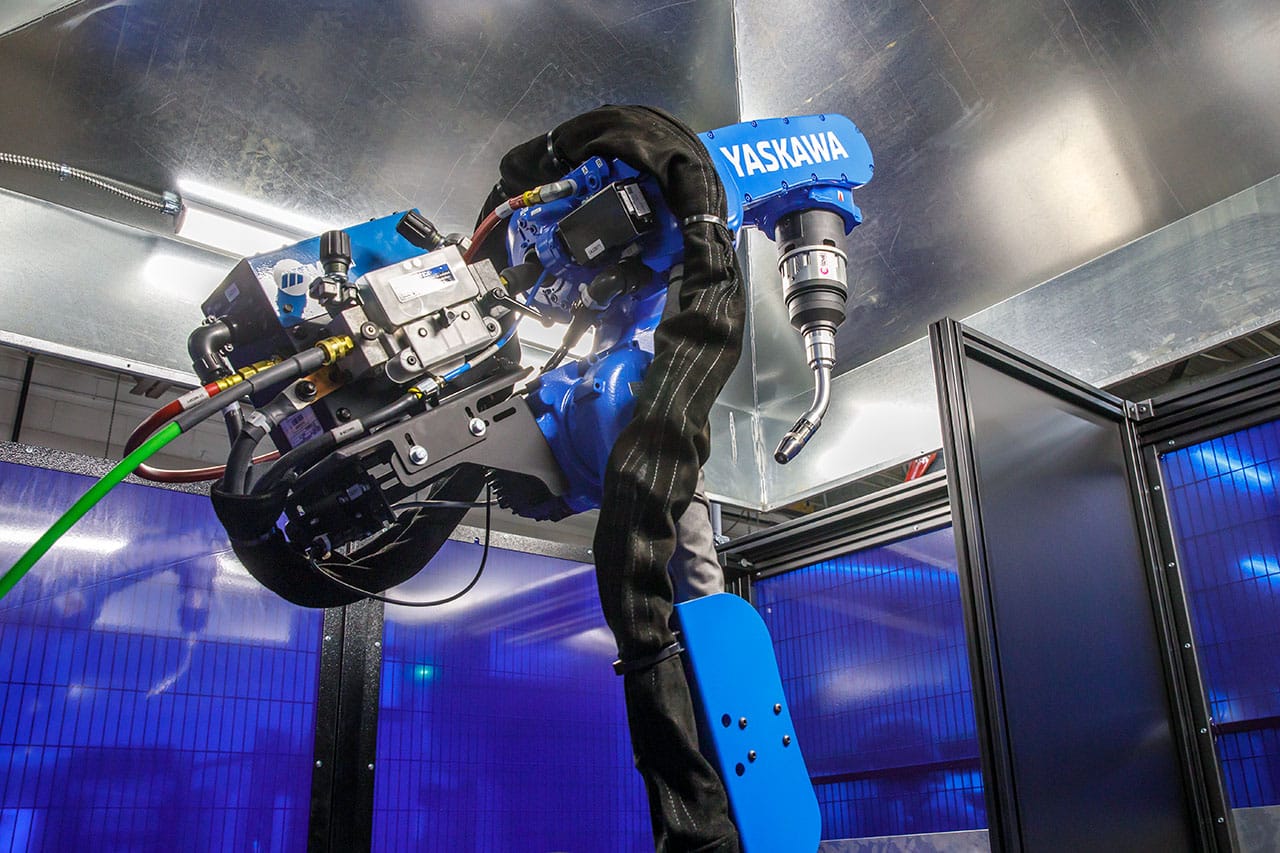Industrial Robotic Welding Cell at Ajax
From prototyping to short-run to high-volume, super-efficient lines, robots can handle an extremely broad spectrum of production assignments. Ajax recently installed a Yaskawa AR1440 robot with a welding effector.

This new welding cell enables Ajax to produce high-quality welds efficiently and consistently and will eliminate many of the bottlenecks associated with manual welding operations. Read more on our Welding page.

The Ajax welding cell is a fully enclosed, dual workstation cell with safety interlocking sliding doors. It features a Miller Auto-Continuum MIG power supply for superior weld control, a smart touchscreen teaching pendant, and faster and more efficient offline programming.
The Metal Forming Benefits of Industrial Robots
From the metal former’s perspective, the benefits of industrial robots are significant and multi-faceted. Primary among them are safety, quality, speed, versatility, and resource allocation. Here’s more detail on each of these benefits:
1. Operator Safety
These days, operator safety is the nut hand*. Many Ajax colleagues have been working together for years and are good friends. No one wants to see a friend get hurt. Robotics can reduce the risk of repetitive motion injury, burn, toxic inhalation, eye damage, and cutting or crushing injury (two thumbs up!). There’s also practical aspects: accidents and injuries can shut down production lines, resulting in late shipments to customers and increased insurance premiums. Anything Ajax can do to reduce that risk is generally worth the expense and effort.
*In poker, the “nut hand” is the strongest possible hand in a given situation and a guaranteed winner. As the story goes, in the old days, a player with such a hand might bet beyond his stake and place the nuts from his wagon wheel on the table, thus assuring other players that he would be unable to flee and would have to make good on his wager.
2. Consistent Quality
Because robotic movements are so precise – generally within 0.02 mm of repeatable accuracy – quality issues are very rare. In fact, it’s far more likely that any non-conformance is related to flaws in materials, fixtures, machine setup, or electrical power interruptions rather than the robotic machinery. Robots make few mistakes, so there’s very little material waste, adding to overall efficiency.
In both production and material handling applications, industrial robots utilize end-of-arm tools (EOATs), also known as end effectors, to hold, manipulate, and perform the work. Robotic effectors, often provided separately by third-party companies, include grippers, magnets, sensors, clamps, suction cups, cameras, welding torches, sanders, and more. The third-party companies that make effectors have come a long way in the past few years and can design their products to take full advantage of the vast range of robotic capabilities.
3. Production Speed
Industrial robots are fast. The volume of parts a robot can crank out in an hour relative to manual production is truly impressive. Even moderately-sized Robotic Weld robots offer thousands of pounds of payload capacity and a reach of 10-20 feet or more. With this kind of range, process improvement engineers can consistently amazing welds. The precise configure robotic solutions that get the job done quickly.
In addition, the fatigue that humans can experience over an eight or ten-hour shift often leads to speed reduction and mistakes. Robots can go at it 24-7 with no performance degradation.
4. Versatility
Industrial robot operating systems are much improved these days, enabling operators to program a wide variety of metal forming tasks. The custom fixtures that hold the workpieces are created in-house, adding to versatility.
Motion controllers, the brains of robots, can be scaled or adapted to meet customer needs relatively quickly. Up to four robots can be added to a single controller to multiply part production. Plus, robots can be programmed to perform multiple jobs in a single setup, reducing project transition times.
5. Operator Assignment
When it’s hard to find good colleagues (like now), robots help shorthanded shifts keep up the pace. A job that might have taken three welders can now be performed by a single robot operator, freeing two workers for other fabrication projects. That’s a huge advantage, especially now.
Conclusion
The manufacturing skills gap persists, despite our best efforts to attract, educate, and grow our manufacturing workforce, making the arrival of industrial robots on the plant floor a welcome sight indeed. Robots bring safety, quality, speed, versatility and other production benefits that are too important to ignore. And for the metal forming customer: consistent conformance, on-time deliveries, and the lowest possible cost.
Yet automation success still hinges on humans. Critical thinking, problem-solving, process engineering, and fine-tuned people skills are needed to amplify the benefits of robots. It’s ironic that industrial automation, often labeled a job-killer in decades past, will instead enhance and extend career opportunities for colleagues willing to learn a new skill set.
Automated production solutions such as industrial robots are a hit because they’re win-win. Both Ajax and our customers will realize the benefits. By investing in industrial robots, and the people we need to engineer and operate them, Ajax is taking yet another big step toward ongoing continuous improvement and maximized customer satisfaction.
Many thanks to our friends at Mechatronic Solutions for their assistance with this robotics project.
